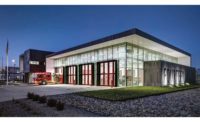Salt Lake City officials unveil on July 19 what they say is the largest public-owned building anywhere to generate as much energy as it uses.
In planning Salt Lake City’s new $125-million Public Safety Building, city officials came to the design team with a full slate of requests. They wanted a building that could withstand and continue to operate after a large-scale earthquake or terrorist attack.
They asked for a building that would be welcoming to the public, could host city events and extend a three-block stretch of public buildings that includes the Matheson Courthouse, the historic City County Building, the Salt Lake City Main Library and Library Square.
And, as the city’s newest public building, the city council and Mayor Ralph Becker wanted the SLC Public Safety Building to exemplify the city’s commitment to sustainability, reducing its impact on the wider environment, says Valerie Nagasawa with Salt Lake City-based GSBS Architects.
“From the start, there was talk about this being a net-zero-energy building,” says Nagasawa, referring to the concept of a building producing through generation and conservation as much energy as it consumes. “Right now, I think we are on track for that.”
Chad Jones, a project manager with construction manager MOCA Systems Inc., agrees, noting that, with 175,500 sq ft of office space, the building will be one of the largest net-zero buildings in the country and the nation’s only net-zero-energy public safety building.
It was designed by GSBS Architects and built by Okland Construction, both of Salt Lake City.
Getting to Zero
One of the more iconic features related to the net-zero goals is the arched canopy stretching from the building’s front entrance onto the public plaza. The canopy not only provides an obvious point of entry to the building but also shades part of the plaza and is covered with photovoltaic panels.
“We expect to generate about 30 KV of electricity from the photovoltaic cells on the canopy,” says Jones. “It is designed and angled to shed snow easily so it should stay clear even in the winter.”
The support columns at base of the canopy are equipped with electrical outlets allowing the public plaza users to tap into the PV power during festivals and other events. The rooftop PV array will generate an estimated 310 KV of power.
In total, the building contains approximately 30,000 sq ft of PV panels, Jones says. Having maximized the site and the building to generate solar power, a PV array off-site near Salt Lake International Airport will make up the difference to help reach project goals, Jones says.
Let the Sunshine In, or Not
The abundant natural sunlight of the Salt Lake Valley will be used for more than just generating power for the new building, says Nagasawa. Daylighting and the sun’s position at different times of the day and the year were significant factors in how the building was oriented and the layout of its interior spaces.







Post a comment to this article
Report Abusive Comment